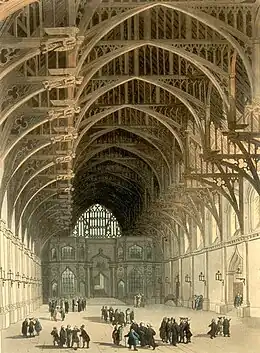'Stop the Rot' is a campaign launched in October 2000 by the Liverpool Echo newspaper with the aim of rescuing and preserving the rich architectural heritage of Liverpool and the greater Merseyside area. The campaign was launched when part of the Casartelli Building in Hanover Street in Liverpool collapsed, and this building subsequently became the symbol of the campaign.
The first meeting of the 'Stop the Rot' committee was held in April 2001 and at that stage there were 11 sites listed by the campaign as most at risk. The programme mobilised public support and received support from leaders of Liverpool City Council and from English Heritage, and as a result in October, with financial assistance from English Heritage, the council appointed a full-time Buildings at Risk officer.[1][2]
Added impetus for the campaign was created by Liverpool being named as the 2008 European City of Culture and a wish for the city to present the best image possible for the expected influx of tourists and visitors.[3]
In 2011 the Creative Ropeworks Project won an award from the Georgian Group for effective preservation of Georgian architecture and the 'Stop the Rot' campaign was highlighted as part of Liverpool's bid.[4][5]
Currently 16 sites remain within the focus of the campaign and at risk. These are as follows:
- 64/72 Seel Street
- 98-102a High Street, Wavertree
- Buddleia Centre
- Cheapside, Liverpool
- St Luke's Church
- Duke Street Terraces
- Newsham Park Hospital
- Scandinavia Hotel
- Seel Street/Slater Street
- Stanley Dock Tobacco Warehouse
- Wellington Rooms[6]
- Welsh Presbyterian Church
- White House Pub
Sites Formerly on the list
- Casartelli Building
- Exchange Buildings
- Fleet Street Warehouses
- St Peter's Catholic Church
- Stanley Buildings
- St Andrew's Church
- The Florence Institute for Boys[7]
- Royal Insurance Building
References
- ↑ Buildings at Risk Initiative Liverpool, UK: Analytical Case Study Archived 14 May 2012 at the Wayback Machine, European Programme for Sustainable Urban Development, October 2010 (pdf), pp. 6, 9. Casartelli Building, p. 13.
- ↑ Ian Weir, "Saving Face: Facade-retention methods in Liverpool's derelict terraces", BuildingConservation.com, retrieved 30 November 2011.
- ↑ Liverpool Vision City Centre Development Update 9 Archived 22 April 2012 at the Wayback Machine, May 2003 (pdf) p. 20, pdf p. 6: "The Liverpool Echo's long-running 'Stop the Rot' campaign has highlighted the scale of the problem and generated an unprecedented level of popular support."
- ↑ "ECHO’s Stop the Rot campaign praised at national Georgian architecture awards", Liverpool Echo 19 November 2011.
- ↑ National praise for Ropewalks, News, Liverpool City Council, 17 November 2011, retrieved 30 November 2011.
- ↑ Wellington Rooms, Liverpool, Heritage Works, retrieved 30 November 2011: "a key public landmark identified by Liverpool City Council in its 'Stop-the-Rot' campaign."
- ↑ "The Florrie: Saving a Liverpool Icon" Archived 12 August 2010 at the Wayback Machine, Nerve 6, Summer 2005.
External links
- 'Stop the Rot' Campaign Site
- Catherine Jones, "ECHO Stop the Rot campaign: We vow to fight on", Liverpool Echo 2 January 2009
- Sandfield Tower
- The Bombed Out Church
